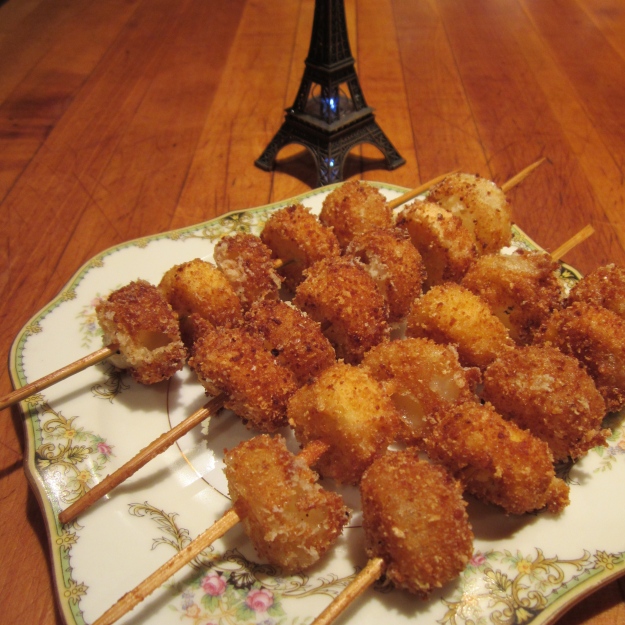It turns out that sultry summer days do not lend themselves at all to Escoffier’s recipes requiring hours at the hot stove. I’ve neglected my cooking and writing for months in favor of bike rides and reading in the sun. But the temperatures have dropped, a fall chill has come to Minnesota, and it’s time to turn on the oven again.
I had a craving for shish kebobs recently, and I wondered how Monsieur Auguste treats food on a skewer. Escoffier lists them under the hot hors d’oeuvre section, and sadly, most of his skewer foods (called “en brochette” in French) include organ meats: veal liver, chicken kidneys, or riz de veau (pancreas). I try not to say “yuck” to many foods, but those just aren’t appealing.
Luckily, one brochette hors d’oeuvre, called Brochettes de Parme, or Attereaux* de Parme, contains only rounds of Gruyère and identically-sized rounds of cornmeal or semolina cooked in white stock then mixed with butter and grated Parmesan. (Pretty much like Italian polenta, but don’t tell the French that!)
Lest you think it’s a simple dish, the next step is to skewer the semolina/cornmeal mixture and Gruyère rounds, dip them in egg then bread crumbs, and, finally, deep fry them.
Everything was going smoothly, no major mishaps–but as I took the crispy rounds from the bubbling fat and was just ready to feel satisfied at a complex task well done, I realized that OMG! I had just cooked up haute cuisine cheese curds!
Brochettes de Parme (adapted from Escoffier’s Le Guide Culinaire)
Prepare a mixture of 200 grams of semolina (or finely ground cornmeal) cooked for approximately 30 minutes in 1 liter of white bouillon (or chicken stock). Remove from the heat and add 150 grams of grated Parmesan and 100 grams of butter. Spread the mixture 1/2 inch thick on a buttered cookie sheet and allow to cool well. (You can even refrigerate over night.)
Cut the semolina mixture into rounds with a 1-inch cookie cutter and impale these on wooden skewers, alternating them with round pieces of Gruyère cheese of the same size and thickness. Dip in beaten egg then in bread crumbs and deep fry at the last minute. The oil should be between 350 and 375 degrees. Deep fry for about 30 seconds or until the rounds are golden brown. Much longer than 30 seconds and the cheese will begin to ooze out of the coating.
Best served warm.
*Attereaux is a skewer generally used for cooking dishes en brochette.


